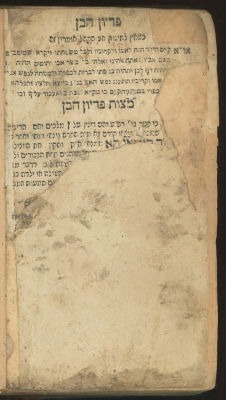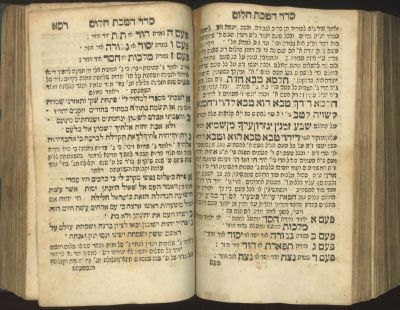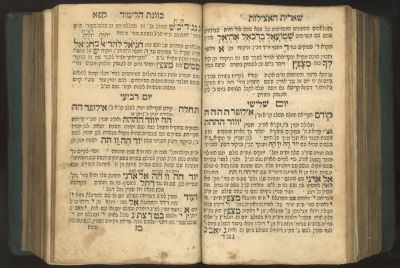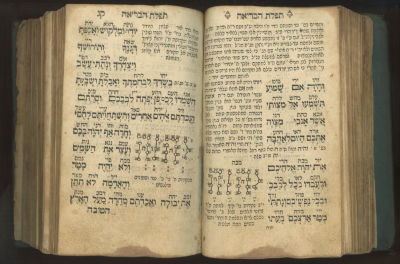"Prayers for the year-round", with kavanot of the Arizal, prayers for weekdays, Shabbat and festivals, Nusach Sefard, compiled by the kabbalist R. Shabtai of Rashkov – a disciple of the Baal Shem Tov. Korets, 1794. First edition.
This siddur is the first to contain kavanot and customs of R. Yisrael Baal Shem Tov – prime teacher of the compiler of this siddur, R. Shabtai of Rashkov. This siddur was deemed holy and revered by prominent Chassidic leaders (for more information about the prominence of this siddur and its author, see below).
This copy starts with page 3, first pg. with marginal repairs, pg. 9-14 repaired mostly in margins, pg. 17 damaged (replaced in manuscript), pg. 18 damaged, pg. 21 repaired in margins, pg. 46-7, 52, 69, 72, 149-152 repaired in the margin, pg. 152 repaired with loss to text, pg. 161-2 repaired, hole in pg. 245.
[1] very rare pg. between pg. 263 & 261 is present but damaged. On this pg. there’s also a stamp of the Admor Rebbe Yisroel Hager of Radovitz. (This Leaf has Hodu and Kegavna, which was only added to a small number of copies)
Pg. 264, 269-273, 289-80 repaired in margins.
On pg. 287 a Kvitel of a Chassid.
Large damage including in text to pg. 291-300, pg. 301-5 repaired, damage to text on pg. 306-311, 324-333, pg. 334-339 used damage with loss to pg. 340, large damage to pg. 341-344.
Copy ends at pg. 344.
Overall in fair shape, with simple old detached binding.
Stefansky Chassidut, no. 412.
Stamp of the Rebbe Yisroel Hager of Radautz (Rădăuți).
Siddur of Rabbi Shabtai of Rashkov:
The siddur of R. Shabtai of Rashkov is the first to contain kavanot and customs of his teacher R. Yisrael Baal Shem Tov. The title page states that "Yichudim from the G-dly and holy Baal Shem Tov, whose name is renowned throughout the world" were added to this siddur.
This siddur is the first to feature the custom innovated by the Baal Shem Tov, of reciting Viyehi Noam and Yoshev BeSeter Elyon seven times at the Chanukah candle lighting ceremony: "And in the name of my teacher R. Yisrael Baal Shem, one should say seven times Viyehi Noam and Yoshev BeSeter in an ordinary way, and he would also recite these Psalms during the High Holidays and at any time of trouble…" (Vol. I, p. 336b).
This is also the source of the Baal Shem Tov’s custom of refraining from idle talk on Shavuot night until after the Kedushah prayer of Mussaf: "In the name of my teacher, one must be very careful after the Tikkun in the night, not to interrupt with any mundane talk, until after Kedushah in Mussaf…" (Vol. II, p. 52b). The page before states: "I received from my teacher, that when Shavuot falls on… one should focus during the reading of the Ten Commandments…". Likewise, he quotes kavanot "from my teacher, which one should focus on during the time of learning early in the morning, as well as kavanot for Hatarat Nedarim (annulment of a vow).
The siddur and its author were deemed holy and highly regarded by Chassidim, and especially by great Chassidic leaders. Seder HaDorot HaChadash (Satmar 1941, p. 19a) states: "R. Shabtai Rashkover, the holy kabbalist, composed a siddur with the kavanot of the Arizal, and it was printed a long time ago, and it is very rare…" (this was written in 1865). Michael Levi Rodkinson writes in his book Toldot Amudei HaChabad (Königsberg 1876, pp. 31-32) that when Rebbe Shneur Zalman of Liadi compiled his siddur "he chose the siddur of Rebbe Shabtai Sheftel of Rashkov from amongst the printed siddurim of the Arizal… and for the most part, he based the text of the prayers in his siddur on the siddur of R. Shabtai Rashkover". Imrei Pinchas HaShalem (I, pp. 223-224) quotes R. Yaakov Shimon son of R. Pinchas of Korets: "One must only pray from the rite of the Arizal printed in Lviv (=1788, R. Asher’s siddur) or from the siddur of R. Shabtai, and not from other editions of the new siddurim". It also brings the words of R. Binyamin Ze’ev of Balta – close disciple of Rebbe Pinchas of Korets: "…the siddur of R. Shabtai is also one of the siddurim we use". The Maggid of Kozhnitz, the Ateret Tzvi of Ziditchov and the Minchat Elazar of Munkacs studied the siddur of R. Shabtai in depth, and annotated it with glosses and commentaries which were later printed. Rebbe Shmuel Abba of Zichlin prayed his entire life from the siddur of R. Shabtai (Lahav Esh, Piotrkow 1935, p. 28).
Rebbe Yisrael of Ruzhin would always pray from the copy of Rebbe Shabtai’s siddur handwritten by the author. Reputedly, after R. Yisrael of Ruzhin moved to Sadigura, "he constantly asked the people around him to make the effort to go bring him the siddur which he left in Iași, since it was handwritten by R. Shabtai… and when they finally brought the siddur to Sadigura, he exclaimed ‘This siddur is my life!’" (Yeshuot Yisrael, Podgórze 1904, II, p. 49).
The kabbalist Rebbe Shabtai son of Rebbe Tzvi Hirsh of Rashkov (Rașcov; b. before 1720? – d. 1781-1784) was a disciple of Rebbe Yisrael Baal Shem Tov and the latter’s sofer. Some say that he was also the disciple of R. Dov Ber, the Maggid of Mezeritch. R. Meir of Premishlan the first served as a teacher of young boys in the home of R. Shabtai, and reputedly, the Baal Shem Tov went to visit them, so that they could together make efforts, through Yichudim and kavanot, to cancel the influence of the Frankist movement which had broadened at that time. R. Shabtai was known as an expert copyist and editor of manuscripts, especially holy manuscripts of the teachings of the Arizal and his disciples.
Thus for instance, Pri Etz Chaim (by R. Chaim Vital), printed in Korets 1785, contains many additions from the disciples of the Arizal which were not included in the first edition: "This comes to improve upon the first, since we toiled and found a very accurate Pri Etz Chaim, copied by R. Shabtai Rashkover, whose writings are all considered perfect…". Reputedly, the Baal Shem Tov asked Rebbe Shabtai to copy for him the composition of the kabbalist Rabbi Heshel Tzoref, "and he gave it to him to copy, and the time was not ripe, until Rebbe Yisrael Baal Shem was summoned to the Heavenly academy". A wondrous story is related regarding the exceptional holiness of the writings of R. Shabtai, in the name of the rabbi of Otyniyia. Once, a manuscript of the siddur of R. Shabtai mistakenly fell into the fireplace without anyone realizing. The fire burnt on it throughout the entire winter, and nevertheless, only the blank leaves of the manuscript got consumed, the rest remained completely intact. R. Shabtai’s year of birth and death are shrouded in mystery. He left behind an illustrious dynasty of Tzaddikim and rebbes, including his son Rebbe Yosef – disciple of R. Pinchas of Korets, his grandson – Rebbe Shlomo Zalmina of Rashkov, his great-grandson – R. Shabtai (the second) of Rashkov, and others (Siddur R. Shabtai, Jerusalem 2008 – biography of the author).
This siddur is based upon previous editions of Ashkenazic siddurim of the Arizal. The first Arizal siddur, printed in Zhovkva in 1781, was compiled by the kabbalist R. Aryeh son of R. Avraham of Zhovkva, with the approbation of the Torah scholars and kabbalists of the Brody Kloiz. Subsequently, R. Asher’s siddur was printed in Lviv, 1788, compiled by R. Asher Margolies of Mezhibuzh – disciple of R. Chaim Sanzer of Brody. In the Lviv 1788 edition, errors that crept into the first edition were corrected, and additions were added based on other books of the writings of the Arizal: Etz Chaim, Sefer HaYichudim, Machberet HaKodesh, as well as "the siddur of the great kabbalist, the renowned Chassid, the G-dly man R. Shabtai of Rashkov" (this siddur was then still in manuscript; from R. Asher Margolies’ preface to his siddur). R. Shabtai’s siddur is thus built upon the siddur printed in Zhovkva 1781, to which Rebbe Shabtai added further important additions from the writings of the Arizal.
Share this lot:
Lot #161


















































